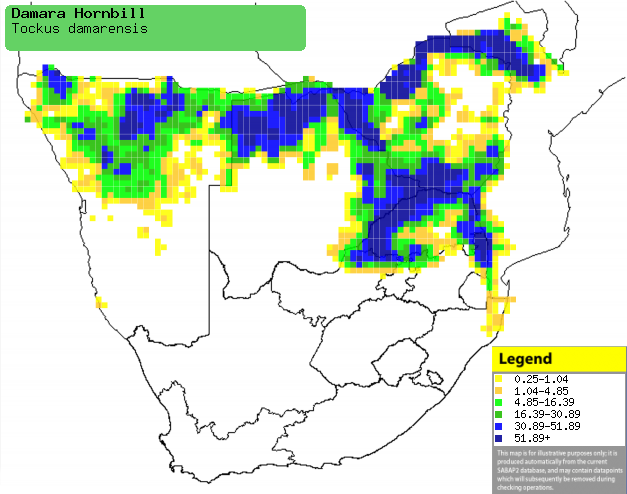|
Tockus damarensis (Damara hornbill)
DamararooibekneushoringvoŽl [Afrikaans]; Calao de Damara
[French]
Life
> Eukaryotes >
Opisthokonta
> Metazoa (animals) >
Bilateria >
Deuterostomia > Chordata >
Craniata > Vertebrata (vertebrates) > Gnathostomata (jawed
vertebrates) > Teleostomi (teleost fish) > Osteichthyes (bony fish) > Class:
Sarcopterygii (lobe-finned
fish) > Stegocephalia (terrestrial
vertebrates) > Tetrapoda
(four-legged vertebrates) > Reptiliomorpha > Amniota >
Reptilia (reptiles) >
Romeriida > Diapsida > Archosauromorpha > Archosauria >
Dinosauria
(dinosaurs) > Saurischia > Theropoda (bipedal predatory dinosaurs) >
Coelurosauria > Maniraptora > Aves
(birds) > Order: Bucerotiformes > Family: Bucerotidae
The Damara Hornbill occurs in Namibia and south-west Angola,
preferring Acacia, Mopane and broad-leaved savanna woodland. It mainly
eats insects, foraging on bare ground but occasionally catching insects in the air.
The nest is usually a natural tree cavity sealed from the inside by the
female. It lays 3-8 eggs, which are incubated by the female for around 24-27
days, with the male doing the hunting for both of them. The chicks stay in the
nest for 18-45 days, becoming fully independent a few days after
fledging.
Distribution and habitat
It occurs from central and north-eastern
Namibia to south-west Angola. It generally favours Acacia woodland, also occurring
in Mopane (Colosphermum mopane) woodland, broad-leaved savanna and
riverine woodland.
|
 |
|
Distribution of Damara hornbill in southern Africa,
based on statistical smoothing of the records from first SA Bird Atlas
Project (©
Animal Demography unit, University of
Cape Town; smoothing by Birgit Erni and Francesca Little). Colours range
from dark blue (most common) through to yellow (least common). |
Predators and parasites
- Predators of eggs and chicks
Food
Mainly eats insects, doing most of its foraging on bare
ground but occasionally catching insects in the air. The following food items have been recorded in its diet:
- Invertebrates
- insects
- other Invertebrates
- Small vertebrates
Breeding
- It usually uses natural tree holes as nests, lining the
interior with leaves. Once a site has been chosen, the female seals the
entrance almost completely, using its own faces and crushed millipedes
brought by the male.
- Egg-laying season peaks from February-March, after the onset of summer
rainfall.
- It lays 3-8 eggs, which are incubated solely by the female for about
24-27 days. The male helps out by giving the female food through the narrow
nest entrance slit.
- The female leaves the nest when the oldest chick is about 18 days of
age, after which the chicks reseal the nest entrance. They stay in the nest
hole for roughly 27 more days, becoming fully independent a few days after
fledging.
Threats
Not threatened.
References
-
Hockey PAR, Dean WRJ and Ryan PG (eds) 2005. Roberts
- Birds of southern Africa, VIIth ed. The Trustees of the John Voelcker
Bird Book Fund, Cape Town.
|
